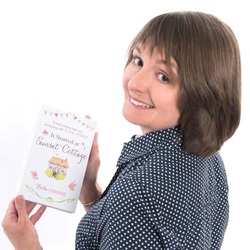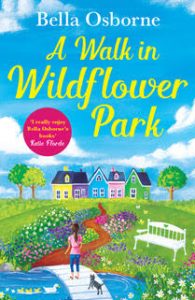How To Plan Your Novel
 I’m a project manager by trade and planning comes naturally so it makes complete sense to me to plan out my novel. Now I know this will have some of you screaming and reaching for the Ben & Jerry’s to comfort you but it’s really not that scary. Planning is not about stubbing out creative flair and spontaneity, it’s simply about putting a structure around it and making it easier for you.
I’m a project manager by trade and planning comes naturally so it makes complete sense to me to plan out my novel. Now I know this will have some of you screaming and reaching for the Ben & Jerry’s to comfort you but it’s really not that scary. Planning is not about stubbing out creative flair and spontaneity, it’s simply about putting a structure around it and making it easier for you.
I often hear the question ‘Are you a plotter or a pantser?’ A pantser is someone who sits down at a blank page and writes by the seat of their pants. I am the polar opposite of a pantser. I am a plotter in the extreme but I don’t expect everyone to be like me, in fact, I’d advise against it. What I do advise is that you find what works for you and that may mean trying out a few approaches until you hit on one that feels right and is most productive.
This is my easy guide to planning your novel:
Put aside time to plan
For me planning is a vital stage of the process so I make time to do it whether that’s sat in the garden thinking, visiting a location for the story or locked in my writing cave – as long as it gets done. A plan, however sketchy, helps to get you started, avoid writer’s block and keeps you going when you get stuck. Without it you’ll probably find yourself staring at that blank page or worse still watching kittens on YouTube. I have nothing against kittens or YouTube, but they are the most awful time stealers.
Know your characters.
Take some time to get to know your characters. There are various ways of doing this. The internet is littered with questionnaires you can use. But as well as what they look like try to understand them better as people. What is driving them and what is their goal? What are they like when they are at their best and worst? Why are they like that? You need to know their backstory even if it never actually appears in the novel. I do bios for all my key characters before I start writing. I even did one for Maurice the cat, in my latest novel A Walk In Wildflower Park. Well, he had a backstory too!
Establish the key events.
I use the Three Act Structure, a tried and tested method, which originated in the theatre and is wonderfully simple. There are lots of examples and templates available online which I’d encourage you to seek out. This structure will help you to identify the key moments in your story and more importantly what the gaps are. You don’t need to know everything that is going to happen but I’d recommend you know what the key event is that starts the story, the major hurdles that will get in the way, important decision points and the secrets and twists which will lead your characters to the conclusion.
Next level of detail.
If you want to you can build on the key events. What are the scenes before and after these events? How has the key event changed the characters? How has it affected them emotionally? What are the consequences of the events and their reactions to it? What do they reveal about each character? How do the shock waves of key scenes ripple through the story? Ensure that every scene has a purpose. If it’s not driving the story or developing the lead characters then why is it there? This level of planning helps you to identify any plot flaws at an early stage.
Make it visual.
Annotate your plan in some way. I have a large corkboard where I pin key plot points. I use coloured pins to denote which story thread it is so I can quickly see if they are well spaced out. Coloured sticky notes work well too and planning is a brilliant excuse to buy them in every colour – you can never have too much stationery. As long as you can move your plot points about because that’s the key. And don’t be scared of changing things around – it’s far better to do it at this stage with a few notes than trying to reorganize a 400 page document.
Top Tip
As well as planning out your story it’s also a good idea to plan out your time. Writing a novel is a lengthy process. Lots of people say ‘Oh, I’d write a novel if I only had the time.’ My first novel was written whilst I was juggling a career, a home and a young child but I did it by grabbing any spare minutes and using them to write. It may mean getting up earlier, staying up later, missing out on must see TV and skipping the vacuuming but if that’s what it takes to make your book happen then that’s what you need to do.
Daily word count targets work for some people and having a plan enables you to maximise all opportunities because you already know what you need to write. Set yourself realistic objectives. Open-ended goals often get usurped by things with firm dates. So put an end date on it and put the time aside to achieve it. And when you get there reward yourself with something nice be that a chocolate biscuit, glass of wine or an episode of your favourite programme.
Good luck and remember – there is no perfect way to write a novel only the way that works best for you.
—
Bella has been jotting down stories as far back as she can remember but decided that 2013 would be the year that she finished a full length novel. Since then she’s written five best selling romantic comedies and she’s been shortlisted twice for the RNA Contemporary Romantic Novel of the Year Award.
Bella’s stories are about friendship, love and coping with what life throws at you. She lives in The Midlands, UK with her husband, daughter and a cat who thinks she’s a dog. When not writing Bella is usually eating custard creams and planning holidays.
For more about Bella, visit her website at www.bellaosborne.com or follow her on social media:
Twitter – https://twitter.com/osborne_bella
Facebook https://www.facebook.com/BellaOsborneAuthor/
Instagram – https://www.instagram.com/bellaosborneauthor/
A WALK IN WILDFLOWER PARK is out 27th June 2019
 When Anna is dumped by her fiancé, she moves in to her own place on the edge of the gorgeous Wildflower Park and pledges to stay off men and focus on her career, but a handsome new colleague seems to thwart her attempts at every turn. And when she receives an accidental text from a mystery man, could it be the new start she needs? Or someone she really shouldn’t be falling for?
When Anna is dumped by her fiancé, she moves in to her own place on the edge of the gorgeous Wildflower Park and pledges to stay off men and focus on her career, but a handsome new colleague seems to thwart her attempts at every turn. And when she receives an accidental text from a mystery man, could it be the new start she needs? Or someone she really shouldn’t be falling for?
Anna’s neighbour Sophie is a stressed-out mum-of-two with a third on the way. Her husband is a constant frustration, and their children are a regular source of newly-invented swear words and unidentifiable sticky surfaces.
Luckily, Anna and Sophie have each other – and Wildflower Park proves to be a sanctuary as they map out a path to find the happiness they both deserve…
Fantastically funny, this irresistibly heart-warming novel will charm fans of Milly Johnson and Jill Mansell.
Category: Contemporary Women Writers, How To and Tips


























Comments (1)
Trackback URL | Comments RSS Feed
Sites That Link to this Post